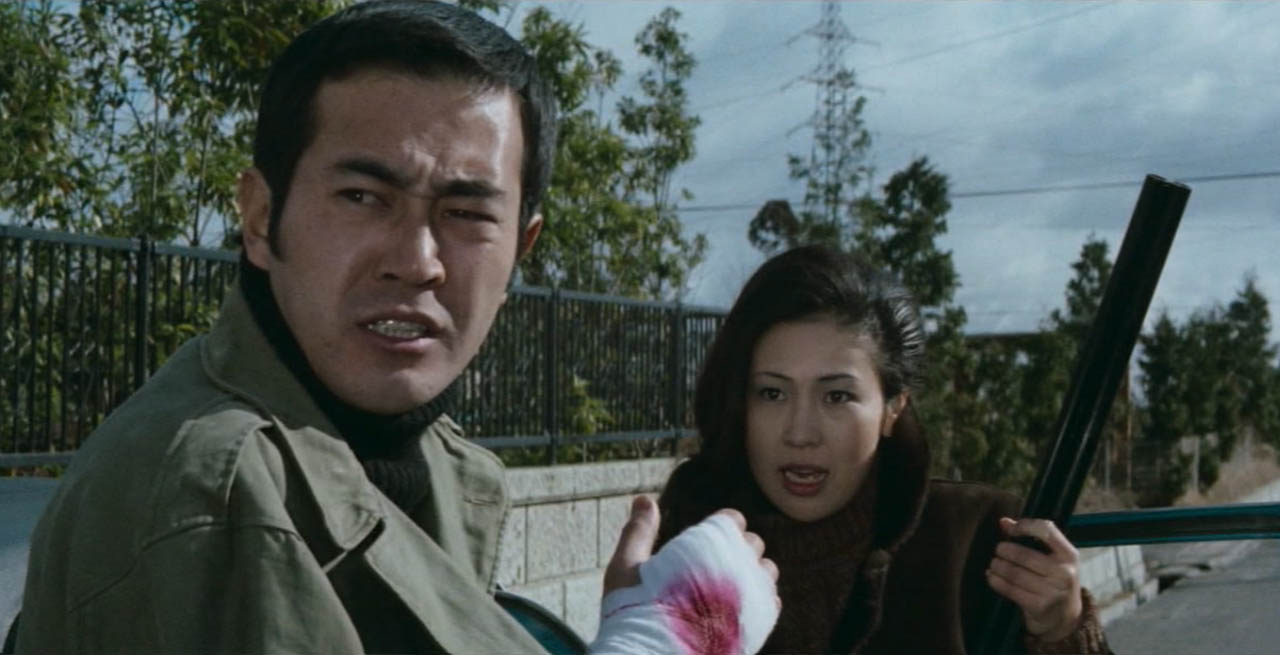
When Toei’s pinky violence line first appeared in 1970 it was an unstoppable force, and throughout the early 70s, it showed little signs of slowing down. 1973 in particular was a bumper year for pinky violence, with an excessive offering consisting of – two Girl Boss films, three Terrifying Girls’ High School films, two Female Prisoner Scorpion films, two Sex & Fury films, and another two standalone sukeban films seeking to diversify the subgenre with Bankaku Rock and Criminal Woman: Killing Melody. By 1974, pinky violence was becoming long-in-the-tooth, and there was little to no fresh ground left that hadn’t been covered already. Whilst it is difficult to gauge whether or not audiences of the day were beginning to tire of the genre, Toei’s management certainly was. The future of their B-film line was seen as ultimately lying in the action genre, with a focus on martial arts which was booming worldwide at the time. Released in March 1974, Female Convict Yakuza would be the first film to bridge the gap into a post-pinky violence era, turning its back on the sex and nudity that had previously drawn in audiences.
The film opens with a heist. A gang of three masked robbers – Hiroshi (Tsunehiko Watase), Ken (Teppei Nagahama), and Yoko (Yoko Horikoshi) – target a credit union and make off with 30 million yen. However, the thieves lose control of the situation and the police quickly arrive when the alarm is activated. The trio manages to slip the money to their fourth accomplice, Chico (Kyoko Naito), who is masquerading as an innocent bystander, but eventually, both Hiroshi and Yoko are arrested. Ken, who has managed to escape, meets up with Chico and the duo hide out together. Hearing news of the heist, a small yakuza gang realises that Ken is a member of the crew and attempts to hunt him down to steal the money for themselves.
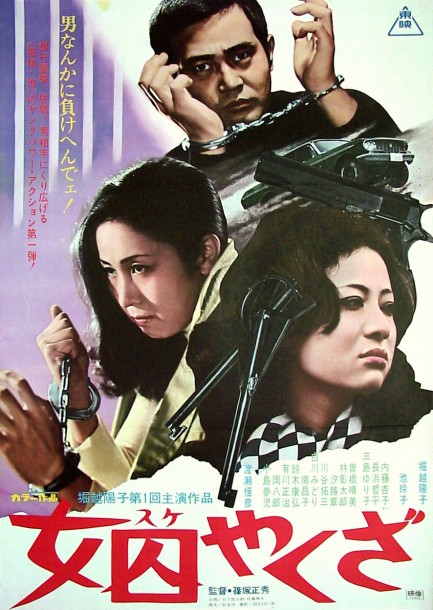
In the meantime, the police are interrogating Hiroshi and Yoko at length to get them to give up the identity of their third member, but they remain vigilant. With the ever-looming threat of the yakuza hanging over them, Chico and Ken split up and Chico goes to visit Yoko at the jail to update her on the situation, slipping her a small note with instructions on where to find them. At the jail, Yoko is placed in a cell with Yuki (Reiko Ike) – a wily sukeban boss who knows fresh meat when she smells it. After becoming privy to Yoko’s heist, she offers to help her and Hiroshi escape from the jail in exchange for becoming the fifth member of the gang. After making their escape, the gang reunites with Ken and Chico, but it’s not long before the yakuza turn up and help themselves to the loot.
Initially feeling thoroughly dejected and hopeless in their hideout, the gang finally comes together, determined to take back what is theirs. After acquiring shotguns and enough ammunition to survive a small siege, the gang takes on the yakuza face-to-face, kidnapping one of their high-up members and recovering the loot in a deadly showdown. The plan is to then flee Japan with the money by sea, but the police aren’t going to let them get away quite so easily.
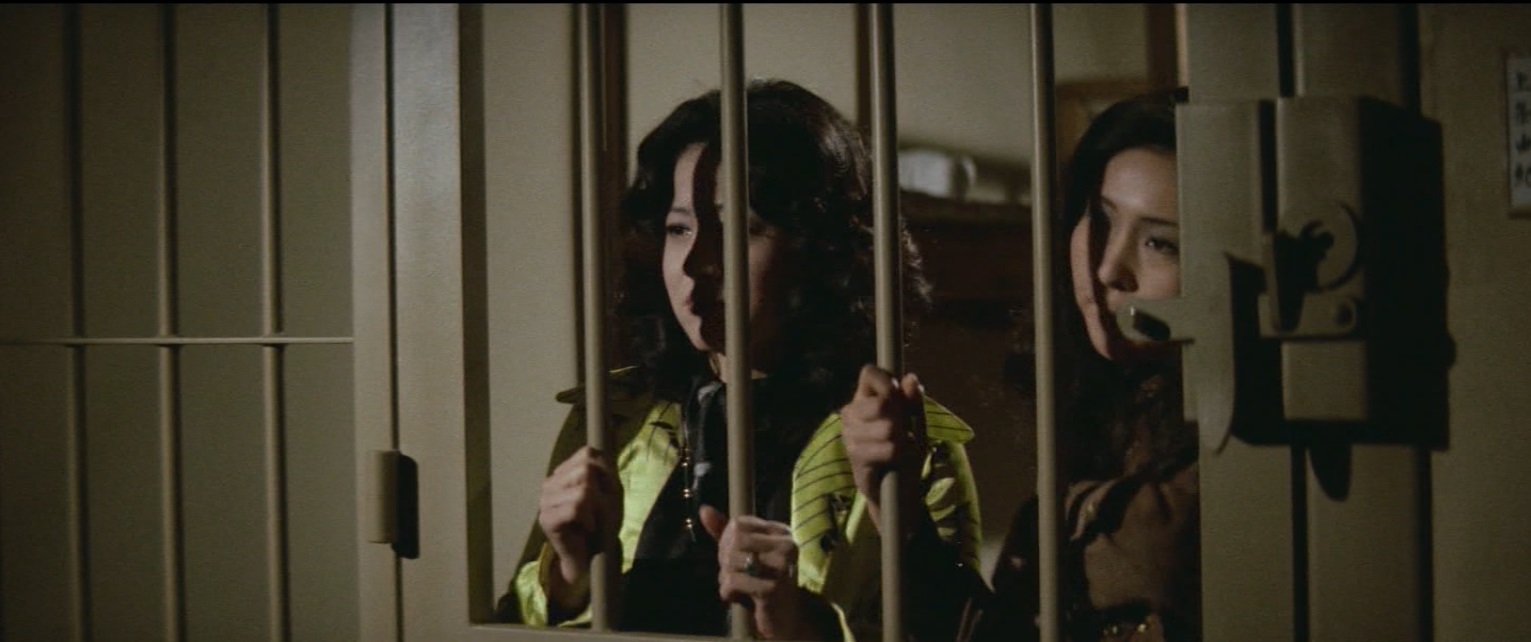
At first glance, Female Convict Yakuza is consistent with everything pinky violence has to offer: from a typical yakuza-action style poster to the title itself. The very name Female Convict (Suke) Yakuza (to include its furigana subtitle) immediately brings to mind Toei’s genre film trifecta; alluding to their Female Prisoner Scorpion films, their long-running Girl Boss series, and, of course, their signature yakuza films which were being dominated at the time by Kinji Fukasaku’s gritty take on the genre. Even the film’s title sequence leans into this comparison, with bleak shots of a sprawling women’s prison which feels straight out of a Female Prisoner Scorpion film. All of this couldn’t be further from the truth, however.
Rather than celebrating the legacy of pinky violence and introducing a focus on action to the fold – much like Young Aristocrats: Maki of the 13 Steps would later do – Female Convict Yakuza presents itself as the ultimate antithesis of pinky violence, even going so far as to seemingly criticise and mock it. Whilst the pinky violence genre heavily focused on larger-than-life badasses dressed in the most fashionable clothes, listening to the most fashionable music, and spouting the kind of stylised dialogue that would make Russ Meyer blush, the characters in Female Convict Yakuza are all, quite frankly, losers.
Yoko at first appears to be the toughest member of the gang: when a cop repeatedly smashes her face into a table to get her to give up Ken, she merely responds with a cocky smirk as blood runs down her face. Although, throughout the film, it is clear she doesn’t have the ruthlessness necessary to be a proper outlaw. Hiroshi sees himself as the charming rogue, though is little more than a slimy bartender with delusions of grandeur as he swaggers around with an unearned arrogance. Ken and Chico are both equally as gormless as each other, with Ken immediately losing his cool at the first sniff of danger; whereas Chico is extremely childlike and spends most of her time fiddling with a kid’s melodica, eating Ritz crackers by the box-full, and generally looking vacant. It’s not just our protagonists who are losers, even the yakuza gang consists of unthreatening snotty pretenders who look more like a bowling team than a serious organised crime group.
Initially appearing as a real-deal hardened criminal, much of Yuki’s role comes in exposing the weaknesses of the gang. The experienced sukeban is the sole member of the gang with any true gumption and has to constantly guide them, all with patronising glee just to further highlight how hopeless they truly are. When things settle down, it is apparent that she might not be as successful as she makes out, and it is clear that her best years as a girl boss are long behind her.
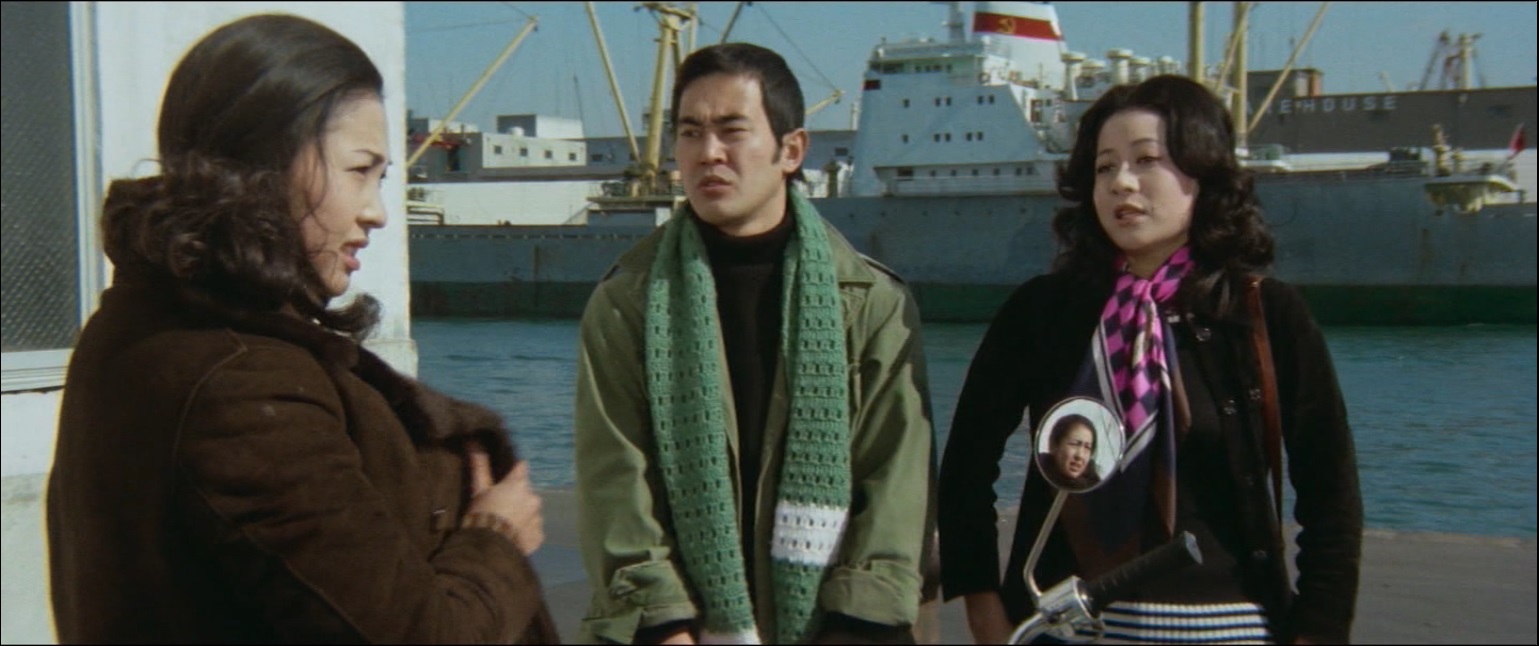
Despite their faults, the gang is extremely endearing. Unlike the indomitable delinquents of pinky violence, the gang represents the true rejects of society, dealt a shitty hand and doing their best to make a success of themselves in the only way possible. They may not be the smartest, bravest, or toughest, but with enough determination, they might just be able to get away with the cash. Female Convict Yakuza is a refreshingly small-scale affair and aligns well with the modest ambitions of its protagonists. The gang doesn’t try to rob a big bank, they settle on a credit union. Hiroshi and Yoko aren’t imprisoned in a high-security prison, they’re sent to a police station’s holding cells. The yakuza gang isn’t some all-powerful conglomerate with unlimited firepower, they’re little more than four punks in a beat-up car. Female Convict Yakuza never tries to be a complex heist film, nor a bombastic action thriller; it is more than happy to settle on a slower, character-driven pace.
The tone and pace are certainly a brave undertaking by director Masahide Shinozuka, who has to trust the audience to follow his vision, despite the marketing very much advertising it as another pinky violence film. He has great faith in his characters to bear the weight of the film, and despite a handful of sillier scenes, he resists the easy route of making the film a comedy. Certainly, Female Convict Yakuza could have made a good spoof of pinky violence if Shinozuka were to highlight the ineptitude of the gang, but his treatment of them is far more earnest. He goes to great lengths to show the robbers in a sympathetic light, and gradually brings the audience around to their side. With the gang’s members representing a range of different personalities, the cast feels tailor-made for the audience to be able to choose and identify with their favourite.

Despite solid performances by the whole cast, it is Reiko Ike’s Yuki who rules the roost. Even though Yuki spends most of the time waiting patiently in the background in more of an advisory role, she has an undeniable impact on the film. When she does open her mouth, every line is delivered with a delicious purring cockiness, very much befitting of the queen of pinky violence. The audience definitely gets the impression that Yuki could easily run rings around the inexperienced gang if she chose to, so it’s a good thing that she’s on their side! Masahide Shinozuka is fully aware that Reiko Ike has the potential to steal almost every scene she appears in, and even though the camera absolutely adores her, her character is used sparingly.
Yoko Horikoshi is a fresh face in the film, and despite Reiko Ike’s experience and popularity, it was Yoko who received top billing. Toei had decided that Reiko Ike (at the grand old age of 21!) was perhaps becoming old-hat to audiences, so made the decision to push Horikoshi as their new female star. Yoko Horikoshi certainly looks the part of a pinky violence heroine, with a pissed-off scowl reminiscent of Miki Sugimoto and a great pair of bell-bottom trousers, though she lacks any real nastiness. Whilst her character was never meant to be a Girl Boss-esque superwoman, Horikoshi lacks a certain sense of conviction to her delivery and appears a little too happy-go-lucky, which is constantly highlighted by Reiko Ike’s strong supporting performance.
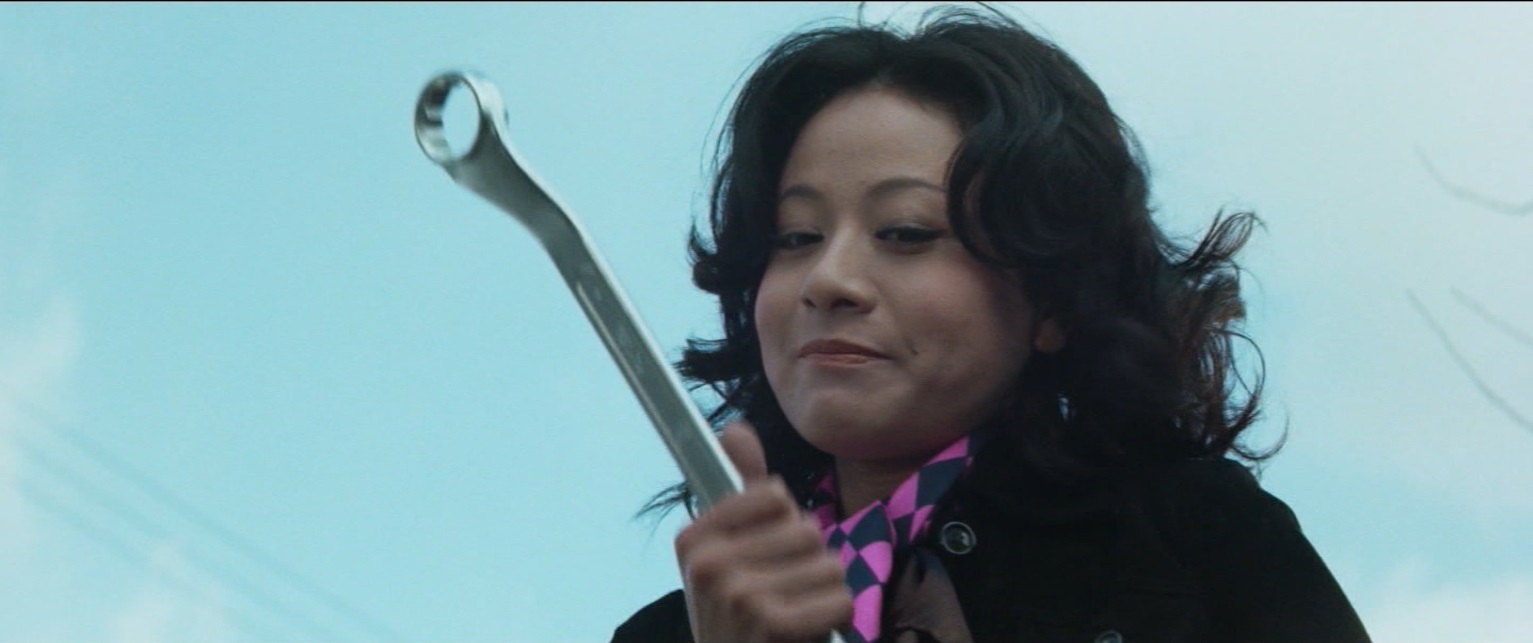
Female Convict Yakuza, despite first impressions, directly subverts every trope of pinky violence and thoroughly turns its back on the usual cooler-than-cool 1970s youth cinema started by Nikkatsu’s Stray Cat Rock series. With both its stars Yoko Horikoshi and Reiko Ike publicly denouncing Toei’s previous focus and obsession with female nudity before the film’s release, Female Convict Yakuza feels almost like a protest film, with director Masahide Shinozuka effectively giving the middle finger to the audience’s expectations. That being said, the film is free of any sense of cynicism and commits to its own unique story and tone. Embracing the flaws of its protagonists, Female Convict Yakuza starts off as a heist tale but excels as a true underdog story, focusing on a gang of misfits and societal rejects.
In spite of its excellent execution, it is admittedly difficult not to feel a little disappointed when you expect to watch 90 minutes of pinky-style action and violence promised by the marketing. Female Convict Yakuza was initially touted as the first entry in a new post-pinky violence film series, although this never came to fruition. Tsunehiko Watase would later appear in the action-heist film Violent Panic: The Big Crash (also featuring Masahide Shinozuka as assistant director), which, if not for its more comedic tone, could be seen as a spiritual successor.
More Film Reviews
Until c.1080 CE, the Temple of Uppsala stood tall and proud outside Gamla Uppsala, Sweden. The temple served as a place of worship and community dedicated to pagan deities such… Director Quinten Dupieux has been building a catalog of films ever since his release of Steak back in 2007. (However, you could argue he defined his image starting all the… For the length of time that zombie movies have been a part of horror, it is only natural that the subgenre would eventually go stale, occasionally requiring a total re-evaluation… The Sergio Blasco Gore Collection is an anthology of four extreme splatter films all created by the Spanish director – Including Burrp (1996), Mas Carnaza (1997), Plano Detalle (2008), and… Oh, the level of alleged and legitimate prestige Dreamcatcher boasts – directed and co-scripted by Lawrence Kasdan (Body Heat) with the help of William Goldman (Marathon Man) from a novel… “People don’t really connect, you know.” A sentiment that is often shared among film fans about some of the most eminent artists in the industry is that they were and/or…The Ritual (2017) Film Analysis – The Demonization of Paganism
Incredible But True (2022) Film Review – Time Travel at its Most Inconvenient
Stacy: Attack of the Schoolgirl Zombies (2001) – Film Review and Retrospective
The Sergio Blasco Gore Collection (2024) Film Review – Extreme Spanish Cinema
Revisiting Dreamcatcher: Bros in the Woods on an Oxy Trip
Revisiting ‘Kairo’ During a Global Pandemic in the Age of Social Media

Hi, I have a borderline obsession with Japanese showa-era culture with much of my free time spent either consuming or researching said culture. Apparently I’m now writing about it as well to share all the useless knowledge I have acquired after countless hours surfing the web and peeling through books and magazines.




